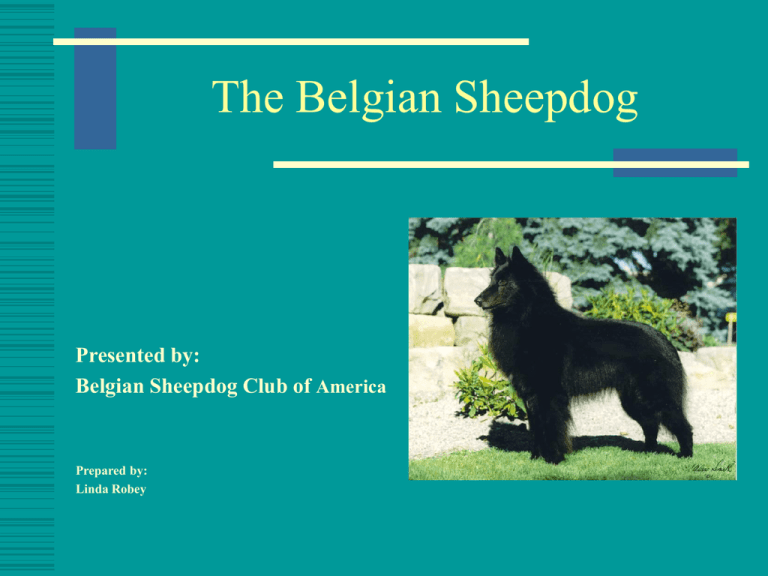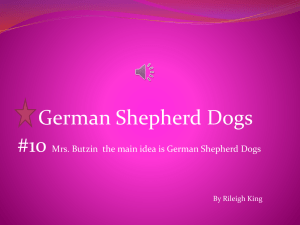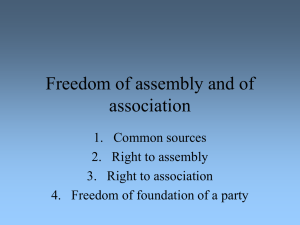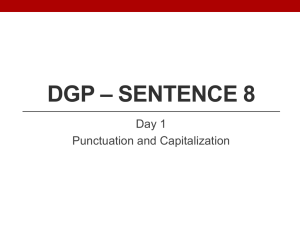
The Belgian Sheepdog
Presented by:
Belgian Sheepdog Club of America
Prepared by:
Linda Robey
Presentation Format
History
The standard and breed type --emphasis on what makes the Belgian
Sheepdog different than the other
herding breeds
History
A Variety of Livestock Dogs
British Herding Dogs
Large sparsely populated areas
Used for gathering or fetching
large herds
Britain as an island had a lack of
natural predators, so unnecessary
for these dogs to have a strong
protective instinct
Example: Border Collie, Collie
Continental Herding Dogs
Small farms where animals were
kept in barns at night
Grazed along side crops so dogs
kept the sheep out of the crops
“living fence”
Predators were a constant threat
so dogs had a natural protective
instinct
Example: Belgian breeds,
German Shepherd
There are also Cattle Dogs and Livestock Guarding Dogs
History
A Variety of Livestock Dogs
While this is an overview of their historic
functions this doesn’t mean that the herding
breeds are strictly confined to their styles.
All herding dogs use fetching and driving
skills to control and move livestock.
History
November 15, 1891, Professor
Reul brought together shepherds
and dog fanciers from the areas
around Brussels, Belgium to ask
if they could find a native
shepherd dog of Belgium.
He found the basic structure and
appearance similar: medium
sized, prick-eared, square, agile,
hardy and intelligent
History
The Belgians were
developed as one
breed with different
coat types and colors
This presentation will
focus on the Belgian
Sheepdog
History
If judging in Canada the breeds name has changed to the
Belgian Shepherd Dog and all 4 breeds are shown together.
The Belgian Laekenois is the 4th Belgian Shepherd Dog
breed and has short wired haired coat.
The Belgian Sheepdog
(Groenendael “Groan-en-dahl”)
Nicholas Rose owned a
famous hotel called
“Chateau de Groenendael”,
10 km south of Brussels
Mr. Rose began a breeding
program that established a
distinct line of long haired
black sheepdogs.
Mr. Rose was the breeder
of Duc de Groenendael,
who is considered the
father of the Belgian
Sheepdog.
History
Father of the Belgian Sheepdog
Duc de Groenendael
Circa 1890s
Square appearing
Elegant with proud neck
& head carriage
Agile
First breed standard was
written 1892
More history is available on the BSCA website
www.bsca.info/history.html
History
The Belgian Sheepdog has
had many jobs over the years.
History
As a Herding Dog
Farmers required herding
ability and protection from
attackers such as wolves
Had to withstand the
climate: heat, cold, snow,
rain
Highly valued for their
trainability and helpfulness
to the farmer
History
As a Police Dog
Belgian Shepherds
were also used as guard
dogs and were the first
dogs to be used by the
Belgian Police
March 1899, the city of
Ghent began it’s police
dog service with 3
Belgian Shepherd
dogs.
History
WWI – War Dogs
During WWI, many
Belgian Shepherds were
requisitioned by the
military
They served in several
capacities during the
war including Red
Cross dogs
They searched for
injured soldiers on the
battlefield
History
WWI – War Dogs
Messenger dogs were
trained to ignore the
sounds of battle and
run through the
battlefields to deliver
important messages.
Arriving in America
The first Belgian
Sheepdogs arrived in
the United States in
1911
They were shown
along with other
shepherd breeds as
Continental Shepherds
Photo courtesy of American Belgian Tervuren Club
The Varieties Become Breeds
in AKC Registration
All Belgians were
registered as one breed
in the US until 1959
In 1959, the breed was
split, the black dogs
took on the original
breed name of Belgian
Sheepdog
Photo courtesy of American Belgian Tervuren Club
•Today the reasons many are attracted to the Belgian Sheepdogs are
the same as in the past.
•Their intelligence, desire to learn and work as a partner with their
owner, and for their agile, efficient working structure.
What Is Breed Type?
Breed type refers to the combination
of specific features that gives an
overall impression to distinguish a
group of dogs as a breed.
General Appearance
Well balanced
Elegant in appearance
Exceedingly proud
carriage of the head
and neck
Stands squarely on all
fours
General Appearance
Strong
Agile
Alert & Full of Life
Impression of Depth
& Solidity without
Bulkiness
Never coarse or
Spindly
General Appearance
Males should be
distinctly masculine
Females should be
distinctly feminine
Should be able to tell
the sex easily by
looking
Bitches should be
given equal
consideration
General Appearance
Please remember
there can be a great
deal of difference
between our dogs
and bitches.
General Appearance - Profile
Males
General Appearance - Profile
Bitches
General Appearance –
Compare - Males
General Appearance –
Compare - Bitches
Size, Proportion, Substance
Males ideal 24” – 26”
Females ideal 22” – 24”
Length from point of
breastbone to point of
rump should equal height
Topline, front legs, & back
legs should approximate a
square
Size, Proportion, Substance Disqualifications
DQ - Males under 22 ½ or over 27 ½
DQ - Females under 20 ½ or over 25 ½
Head
The head is very important in
distinguishing a good Belgian
Sheepdog. Head type is a
combination of - correctly set
ears, eye color and shape
and proper proportion.
When looking at the head, a
judge should be able to tell
the breed and even the sex.
Head
Clean-cut & Strong
Top skull flattened rather
than rounded
Stop moderate
Skull - width
approximately the same,
but not wider than the
length
Muzzle & Skull equal in
length
Head
Alert
Ready for activity
Gaze should be
intelligent and
questioning
Head - Ears
Ears triangular in shape
Stiff and Erect
Set high on the head
Base of ear should not
come below center of
eye
DQ – ears hanging
Head – Ears
Head - Ears
Head - Eyes
Medium size
Slightly almond shaped
Brown, preferably dark
brown
Head
The difference between
dogs and bitches
should be easily
apparent.
Is there any doubt that
this is a bitch?
Head
Head
Good Examples - Heads
Nice bitch heads
Good Examples - Heads
Nice male heads
Head - Bite & Teeth
Even or scissors, both
acceptable
Should not be over or
undershot
Full complement of
strong white teeth
Examining the Bite
Lift the front of the
lips and check for
Scissors bite or
even bite.
This is a nice
scissors bite.
Examining the Bite
While the standard calls for
“a full complement of
strong white teeth” it is not
necessary to open the
entire mouth.
Lift the sides of the mouth
to examine our bites.
The small pre-molars are
the teeth normally missing.
Please do not pry open the mouth as done in the Rottweiler
Neck
Round & rather
outstretched
Skin tight
Slightly arched
Carries the head
proudly
Neck
Beautiful elegant neck
Too short lacks elegance
Topline
Withers slightly
higher and slope into
the back
Back level, straight &
firm
Loin relatively short
Croup medium long
& slightly sloping
Chest
Deep not broad
Lowest point reaches
the elbow
Forechest apparent to
the extent that it is not
hidden inside the
shoulders
Withers to chest =
elbow to ground
Tail
Last bone to reach the
hock
Tail low at rest
Tail lifted during
movement, but should
not be carried above
the backline or hooked,
may have slight curl
DQ – Cropped or
Stump tail
Forequarters - Shoulder
Long, oblique, flat
against the body
Shoulder & upper arm
meet at a sharp angle
(approx 90º)
Shoulder & upper arm
approximately equal in
length, this sets the
elbow under the top of
the withers
Forequarters – Legs & Feet
Legs straight & parallel
to each other
Bone oval
Pasterns medium in
length & very slightly
sloping
Feet round (cat feet)
Hindquarters - Legs
Thighs broad and
muscled
In balance with the
forequarters
Hock low to ground &
moderately bent
Feet slightly elongated
Coat
Medium harsh coat
Guard hairs long, well
fitting, straight
Undercoat dense
commensurate with the
climate
Excessive coat that would
interfere with the working
ability or masks the elegant
outline should be faulted
Coat
Bitches seldom carry
the same coat as males
Bitches should be
given equal
consideration when
judging
Don’t be distracted by
the amount of coat,
proper texture is more
important
Color
Black
May have white, limited as
follows:
Small to moderate patch or
strip on forechest
Between pads of feet
Tips of hind toes
Chin and muzzle (frost maybe
white or grey)
Tips of front toes allowable but
a fault
Color
May have white, limited as:
White or gray is
acceptable on chin and
muzzle
Frosting can be on
young dogs. It is not
age related
White around the lower
lip and over the eye
brows are age related.
Color
May have white, limited as:
Small to moderate
white patch or strip on
forechest is acceptable
The standard does not
define the size of the
white other than small
to moderate
Color
May have white, limited as:
White on tips of hind
toes allowed in the
standard
White is allowed
between the pads of the
feet
White on tips of the
front toes are allowable
but considered a fault
Color
Reddening due to
climactic conditions
in an otherwise
correct coat should
not be grounds for
disqualification
Belgian Sheepdog Color
Disqualifications
Gait - Side
Smooth, free, and easy
Never tiring
Backline firm & level
Parallel to the line of
motion, no crabbing
Tail not above the
backline
Always appearing agile
Gait – Coming & Going
Tends to
single track
Correct
coming and
going is
important in
our agile
herding dog
Disqualifications - Summary
SIZE
Males under 22 ½ inches or over 27 ½ inches
Females under 20 ½ inches or over 25 ½ inches
Ears hanging (as a hound)
Cropped or stump tail
Any color other than black
Viciousness
Temperament
Qualities of intelligence
Alert & devoted to master
Watchful & attentive
Zealous for the attention of their master and
very possessive
Approachable & confident
Please do not award points to a dog that
does not display the proper temperament.
Judging the Belgian Sheepdog
Mostly owner handlers
Approach with confidence
Many dogs will not be hand stacked, they are
trained to move into position and stand
The dogs are very focused on the handler
make sure they know you are coming
NEVER accept questionable temperament
Summary
Judging is a balancing
act
Always consider the
entire dog
Look for the best
balance of positive
points that are specific
and functional for the
breed.
Summary
A Belgian Sheepdog must
have good breed type to
distinguish it from other
herding breeds
A Belgian Sheepdog must
be sound with good
movement to perform the
functions they were bred
for.
Summary
We ask you to
consider the overall
look of breed type
and the purpose of
the breed in the final
analysis, weighing
the virtues against
the faults.
This Slide Is to Remind You
That the Belgian Sheepdog
Is More Than a Pretty Face.
To be a good Belgian Sheepdog it must look
like and act like a Belgian Sheepdog.
Conclusion
The Belgian Sheepdog Club
of America thanks you for
your interest in improving
conformation judging of the
Belgian Sheepdog.
Additional Information
Website – WWW. BSCA.INFO






